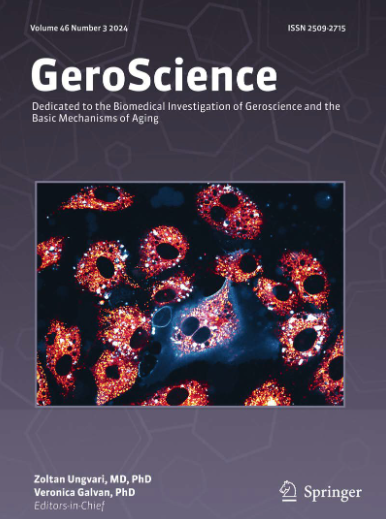抗阻训练,而不是亮氨酸,增加了基础肌肉蛋白质的合成,逆转了老年妇女摄入优化蛋白质的虚弱。
IF 5.4
2区 医学
Q1 GERIATRICS & GERONTOLOGY
引用次数: 0
摘要
虚弱通常与肌肉减少症有关,包括肌肉力量和质量的减少。虽然肌肉减少症有多种原因,肌肉蛋白质合成受损可能是原因之一。亮氨酸和抗阻训练(RT)是一种合成代谢刺激,但亮氨酸联合RT对虚弱的老年妇女的长期影响尚不清楚。这项双盲、安慰剂对照研究旨在评估它们对摄入足够蛋白质的女性肌肉合成代谢和特征的影响。前期/体弱老年妇女(n = 19, 77.5±1.3 y, BMI: 25.1±0.9 kg/m2),接受为期12周的蛋白质优化饮食(1.2 g⋅kg BW-1⋅d-1),随机分为7.5 g/d亮氨酸(Leu)组和5.1 g/d丙氨酸(Ala)组。主要结果是吸收后和餐后状态下的肌纤维分数合成率(MyoFSR)。次要结果是蛋白质含量和表达的变化,1次重复最大值,体成分(DXA)和肌纤维谱的研究。总体MyoFSR增加了47%,同时增加了1型和2a型肌纤维横截面积(CSA)(分别为16%和28%)和总瘦质量(2%)。总AKT、S6和AMPKα水平不变。然而,AKT和S6的磷酸化水平在放疗前餐后升高,而在放疗后没有变化。虚弱标准的数量减少了64%,身体功能和力量得到改善。亮氨酸没有额外的合成代谢益处。最佳蛋白质摄入量的RT显著改善了脆性表型,增加了基础肌ofsr以及1型和2a型肌纤维CSA和总瘦质量,没有补充亮氨酸的额外好处。本文章由计算机程序翻译,如有差异,请以英文原文为准。
Resistance training, but not leucine, increased basal muscle protein synthesis and reversed frailty in older women consuming optimized protein intake.
Frailty, often linked to sarcopenia, involves reduced muscle strength and mass. While sarcopenia has multiple causes, impaired muscle protein synthesis may contribute. Leucine and resistance training (RT) are anabolic stimuli, but the long-term effects of leucine combined with RT in pre/frail older women remain unclear. This double-blind, placebo-controlled study aimed to assess their impact on muscle anabolism and characteristics in women consuming adequate protein. Pre/frail elderly women (n = 19, 77.5 ± 1.3 y, BMI: 25.1 ± 0.9 kg/m2), underwent 12 weeks of RT with protein-optimized diet (1.2 g⋅kg BW-1⋅d-1) and were randomized to 7.5 g/d of leucine (Leu) or placebo 5.1 g/d alanine (Ala). The primary outcome was myofibrillar fractional synthesis rate (MyoFSR) in the postabsorptive and postprandial states. Secondary outcomes are changes in protein content and expression, 1-repetition maximum, body composition (DXA), and myofiber profiles were investigated. Overall MyoFSR increased by 47%, with a concomitant increase in type 1 and 2a myofiber cross sectional area (CSA) (16% and 28%, respectively), and total lean mass (2%). Total AKT, S6, and AMPKα levels were unchanged. However, AKT and S6 phosphorylation increased postprandially before RT, with no change following RT. The number of Frailty Criteria was reduced by 64%, with improvements in physical function and strength. Leucine had no added anabolic benefit. RT with optimal protein intake significantly improved the Frailty Phenotype and increased basal MyoFSR along with type 1 and 2a myofiber CSA and total lean mass, with no added benefit of leucine supplementation.
求助全文
通过发布文献求助,成功后即可免费获取论文全文。
去求助
来源期刊

GeroScience
Medicine-Complementary and Alternative Medicine
CiteScore
10.50
自引率
5.40%
发文量
182
期刊介绍:
GeroScience is a bi-monthly, international, peer-reviewed journal that publishes articles related to research in the biology of aging and research on biomedical applications that impact aging. The scope of articles to be considered include evolutionary biology, biophysics, genetics, genomics, proteomics, molecular biology, cell biology, biochemistry, endocrinology, immunology, physiology, pharmacology, neuroscience, and psychology.
 求助内容:
求助内容: 应助结果提醒方式:
应助结果提醒方式:


